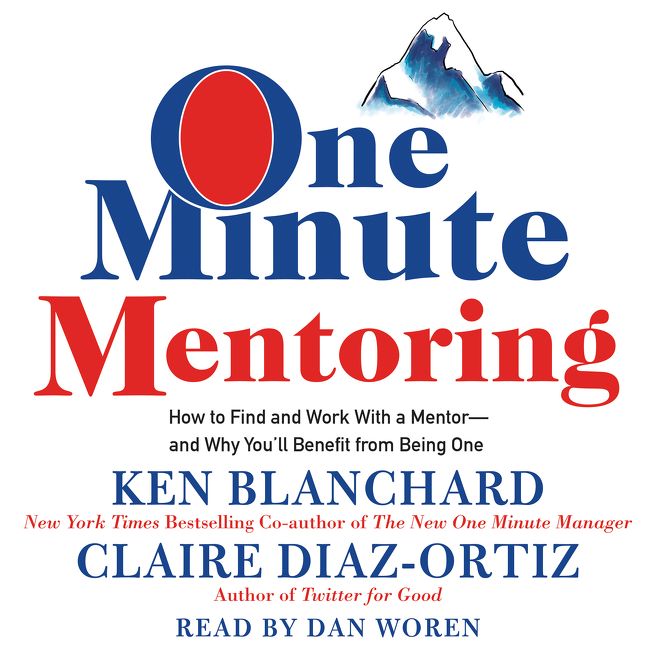“If you light a lamp for someone, it will also brighten your own path.” – Ancient Buddhist Proverb
In One Minute Mentoring: How to Find and Work With a Mentor–And Why You’ll Benefit from Being One, authors Ken Blanchard and Claire Diaz-Ortiz share a fictional parable about the power of finding—or being—a mentor. They share a framework for maintaining a mentoring relationship.
In One Minute Mentoring, Ken and Claire tell the story of Josh Hartfield, a young sales rep whose motivation is flagging, and Diane Bertman, a sales executive whose crammed schedule isn’t delivering the satisfaction it once did. As the story of Diane and Josh unfolds, the authors share six action steps to creating a successful mentoring relationship, as developing and finding a mentorship partnership, and strategies for skills and wisdoms of people of all ages.
The One Minute Series
- The guidance that really made a difference did not come in the form of long, complex theories—it came in short, meaningful insights. The one-minute book series is a series of short books that focus on a particular theme, e.g. one-minute manager, one-minute salesperson and the one-minute mentor.
Mentoring vs Coaching
- A coach helps you focus on performance and skill development.
- A mentor helps you focus on longer-term issues—things like work-life balance and big-picture career development.
Coaching is focused on short-term, task-related issues. Mentoring focuses on big- picture, long-term goals.
Like mentoring, coaching is a one-to-one process. But the relationship between an individual and a coach has very specific objectives and goals focused on developing potential, improving relationships, and enhancing performance. Although mentors utilize coaching skills to serve the mentee, mentoring involves additional tasks, which can include:
Being a role model – displaying specific activities and behaviors that are role-specific :
- Consulting – sharing information about the industry, company, or business unit that the mentor believes is relevant to mentee.
- Brokering – making introductions to powerful, influential, and otherwise useful individuals in the industry or organization.
- Advocating – for a mentee’s work assignments or career development, to help the mentee’s growth and development
Types of Mentoring
New-Hire Mentoring
Many organizations have developed formal mentoring programs for newly hired employees. The concept is simple: pair up a new hire with an old hand, and watch the new hire learn and grow.
Peer-to-Peer Mentoring in a Company Context
These mentoring programs pair peers within an organization to mentor each other.
Cross-Generational Mentoring:
This involves two people from different generations pairing up for mutual benefit and growth. Often a mentor-mentee relationship grows into a cross-generational mentorship.
Adult-to-Adolescent Mentoring:
Organizations like Big Brothers Big Sisters pair adults with youth to give them role models and positive guidance.
Mentoring Never Ends
A mentor for one phase of your life may not be the person you need at another point.
Finding a Mentor
A mentor doesn’t necessarily have to be in your chosen field. As you search for a mentor, make sure you turn over every stone. Think about former supervisors, college alumni, teachers, professors, neighbors, friends, family, company pro- grams, professional associations, volunteer organizations, and online mentoring organizations.
Potential mentors are all around you once you start looking for them.
Essence and Form
The two aspects of working with someone else— essence and form
- Essence is all about sharing heart-to-heart and finding common values.
- Form is about structure – how we might work together.
Mission Imperative
Successful mentoring starts with a powerful mission statement. What do you hope to achieve with your partnership? Articulate your mission in a simple statement you can readily call upon.
A mission gets at the purpose of our mentoring relationship. While our mission statement doesn’t have to be complicated, it should be written with care, because it will be the most important thing we’ll agree on together.
Create a mission— a purpose for your mentoring partnership.
Communication: Rules of Engagement
Set some ground rules early on for the type of engagement you expect from each other. How often will you meet? Will you call, text,or e-mail between meetings? How frequently?
Agree on ways to engage that work with your personalities and schedules.
Speak Your Truth
As a mentor, encourage your mentee to tell the truth about where they are and what they want. At the same time, tell the truth about where you are and what you want. As a mentee, you have observations to offer as well. Don’t fall into the trap of letting your mentor always take the lead in conversations.
The Mentor Model
Mission Engagement Network Trust Opportunity Review and Renewal
M = Mission
TAKE ACTION:
It is essential to create a vision and purpose for your future mentoring partnership. Approach a prospective mentor or mentee with courtesy and respect. Regardless of the outcome, thank them for their time. Develop a short mission statement to set your intention and direct the mentor/mentee relationship.
E = ENGAGEMENT
- Agree on ways to engage that work for your personalities and schedules.
- Make a commitment to regular meetings, at least, even if they are virtual.
N = NETWORKING
Expand your network with that of your mentor or mentee. But remember: tread carefully on the networking contacts of your mentoring partner.
T = TRUST
- Build and maintain trust with your mentoring partner by telling the truth, staying connected, and being dependable.
O = OPPORTUNITY
- Create opportunities for your mentee or mentor to grow.
R = REVIEW AND RENEWAL
- Schedule a regular time to review progress and renew your mentoring partnership.
All the best in your quest to get better. Don’t Settle: Live with Passion.



Comments are closed.